Go Back to current column
Umbria Photo Workshops - Fall, 2011 (see below!)
Battle of the Big Minis: X100, X1 and G12
High-End Point & Shoots Can Offer Great Images
By Frank Van Riper
Photography Columnist
The great color photographer Jay Maisel once said that “to be a photographer, you must photograph every day.” And Jay, a strapping Brooklynite, followed his own dictum, lugging at least one big-gun Nikon with him wherever he went.
For the rest of us, carrying around a full-sized SLR—never mind a medium format rig--can be daunting, or at least such an awkward and heavy task that doing it every day can be problematic . Amateurs are, well, amateurs, and therefore cannot be expected to share the zeal of a pro like Maisel. And pros like me, who work with their gear every day to make a buck, can be forgiven, I think, for wanting a day off every now and again.
Which is why pro-level point and shoot cameras, with their continuing improvement over the years, offer each of us the chance to shoot every day and not feel as if we are on a photographic forced march with heavy pack.
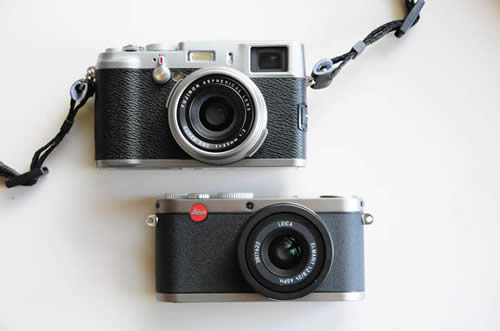 |
You might be forgiven for confusing the very-retro Fuji X100 (top) with an old Leica M3. The Leica X1 (bottom) is simplicity itself compared to the Fuji camera. © Frank Van Riper |
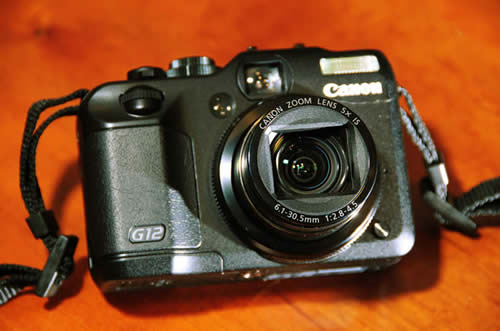 |
Canon blew the doors off the high-end Point and Shoot market years ago with its top P&S model, the G-9. The new G12 (above) continues in that tradition. © Frank Van Riper |
I have written about high-end P&S cameras for years now, going back to the ancient days of film and Nikon’s top-shelf CoolPix models, and my own all-time favorite point and shoot film camera: the great Leica Minilux.
In today’s digital market the field is crowded with small cameras capable of producing remarkable photos of previously unheard of quality. Hell, even the iPhone camera is capable of producing eye-popping 8x10s—with even better capability on the horizon.
But for the pro or serious amateur, searching for a point and shoot camera with really professional features like RAW capability, full manual control, film-like resolution—and of course no damn shutter lag—can seem like searching for the Holy Grail.
Now, however, if we have not actually got the sacred goblet in our grasp, we at least have it in our sight.
Three new (or newly improved) point and shoot cameras (I do not pretend to have tried all the great ones out there, only the following terrific ones) seem to offer the best in terms of image quality, features and portability. They are the Canon PowerShot G12, (list $500) the Fuji X100 ($1200) and the Leica X1 ($1800).
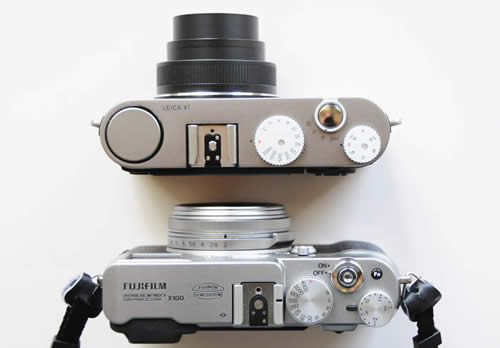 |
Both the X1 (above) and the X100 display blessedly simple analog controls, though the X100's firmware can be daunting. Fuji appears to appreciate this. © Frank Van Riper |
Some general comments on all three cameras:
Interestingly, since it is the cheapest, the Canon G12 is the only one of the above three cameras that features a zoom lens—a 28mm-140mm equivalent; f.2.8-4.5. Both the X100 and the X1 offer excellent fixed focal length prime lenses, meaning you have to zoom with your feet. [The Fuji comes with a fixed 23mm f.2 lens; the Leica with a fixed 24mm f.2.8. These translate roughly into a 35mm medium wide-angle lens on a 35mm film camera or full frame DSLR. Note too that in low-light situations, Fuji’s extra stop of light-gathering power could be a godsend.]
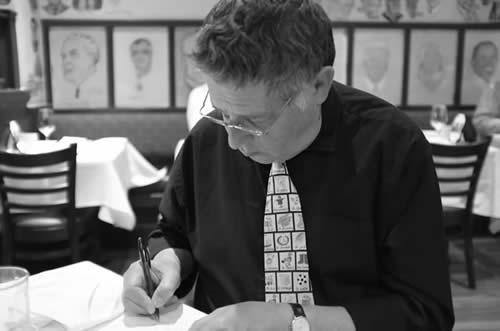 |
Veteran photojournalist Harry Hamburg, in from London, doing his credit card math after lunch at The Palm in Washington. BxW grab shot made by available light with a Fuji X100 © Frank Van Riper |
All three cameras have (or can be accompanied by) eye-level viewfinders and are capable of producing mural-sized prints: both the G12 and the X100 are 12mp cameras; the Leica X1 11 mp. Note: The X1 eye-level finder is an option that fits into its hotshoe and provides a very accurate view of what the the parameters of the final image will be.
To be sure, none of these machines can replace a full-featured DSLR, but each comes close. One, the Canon G12, is the oldest of the group--a new and improved version of Canon’s now-legendary pro-level point and shoot that debuted several years ago with the G9. In fact, one might be tempted to go with this very reasonably priced camera simply because it is NOT a new model, but one that has undergone several generations of upgrades and improvements. One upgrade: a jump from 10mp to 12. [Note: This is the same theory that says you should not be the first to buy a new model of a car, but instead wait for the bugs to be ironed out of what, to all intents and purposes, is a prototype, or Beta version.]
As the cheapest of the three cameras by far, it probably should not surprise that the G12 has a plastic body, compared to metal for the X100 and X1. But it is a well-made sucker, easily one of the most rugged small cameras I ever have used. And it easily fits into a purse or shirt pocket, the better to follow the shoot-every-day dictum of Jay Maisel. Though a sophisticated camera—it IS Canon’s top-of-the-line P&S—the G12’s operating system is surprisingly easy to use, in stark contrast to the Fuji X100.
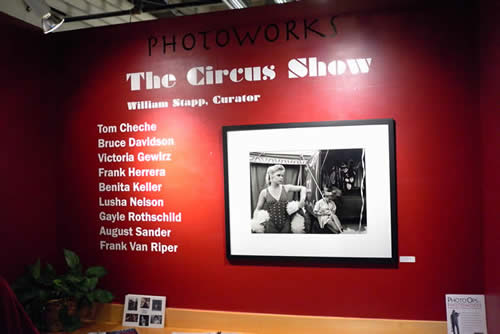 |
I made this shot to see how well the Leica X1 worked by available light (great) and also to have a reminder of perhaps the only time I ever will be in a show with Bruce Davidson and August Sander. © Frank Van Riper |
In fact, following the don’t-buy-the-first-model reasoning of car-buying, one might not be tempted to rush out to buy the groundbreaking, mega-ballyhooed Fuji X100--a beautifully made, gorgeously retro-looking, hybrid rangefinder camera that I dearly wanted to love but could not because of its ridiculously complicated firmware. Almost everything else about this camera is wonderful: all metal, it’s built like a little tank, yet is compact and lightweight; its optics are superb. It looks like a miniature Leica M3. Would that it were as easy to use.
Prediction: even now I suspect, Fuji brass are making at least one clueless engineer walk the plank for the dog’s lunch of a firmware package he cobbled together for them, and that within a year a new model of this camera (the X200?) will debut with a brand new, radically easier-to-use, operating system. (Even as I write this, Fuji is back-pedaling furiously, offering firmware fixes to its earliest customers, much as Leica tried to retrofit its trouble-plagued M8 digital rangefinder camera a few years back, before it swept aside all competition with its masterpiece digital rangefinder: the Leica M9.)
Mark my words: with all that is right with the X100, when and if Fuji cleans up the mess of its firmware, this camera will be a game-changer.
Of the three cameras I field-tested, the Leica X1 was by far the simplest—and, as it happens, the most expensive, at a list price of $1800. Part of this, of course, reflects the Leica mystique for quality and durability—dismissed by some as marketing hype, but viewed by others (myself included) as a reputation well-earned. Compared to the hoops one has to jump through with the X100, the X1 is simplicity itself, while also giving you a full range of manual options, not to mention images of such sharpness and contrast that they fairly shout Leica glass. Where some elements of the Fuji camera seem too clever by half, such as its hybrid viewing system (see below) the Leica seems to revel in its role as a P&S version of the great M9 (and, by Leica standards anyway, reasonably priced by comparison.)
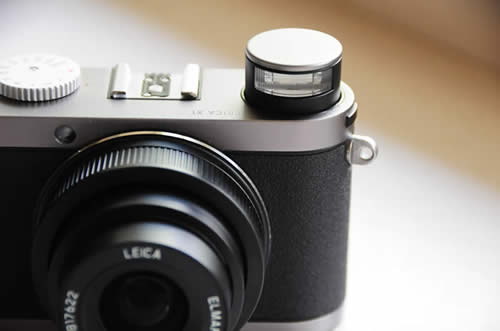 |
Illustrative of the Leica X1's simplicity is its (literal) pop-up flash. You press on the top of the thing and it pops up, ready to fire. What a concept! © Frank Van Riper |
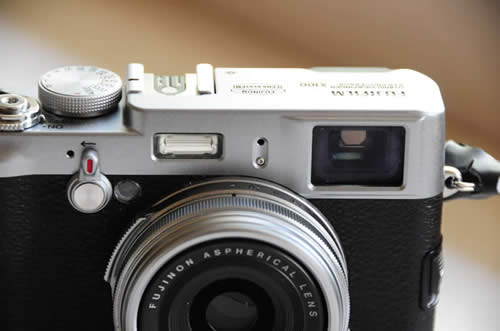 |
The flash on the Fuji X100 (center, above lens), like those on other P&S cameras, is enabled by setting flash menu.© Frank Van Riper |
I keep thinking of the X1’s pop-up flash. It literally does pop up, in the manner of a handle-free Scandinavian-designed cabinet door that you push on to open. Do this to the X1 and you are ready to shoot flash photos. What a concept! On the two other cameras, you have to activate the flash by pushing a series of menu buttons.
Never underestimate the elegance of simplicity. Or, for the matter how much Leica has put into this package. The X1’s sensor—virtually identical to that of the Nikon D300, a great all-around DSLR--is 8 times bigger than that of the Leica D-lux, its popular consumer-grade P&S. It’s not for nothing that Leica marketing vice president Christian Ehrhardt views the X1 as “the small brother of the M cameras of old.”
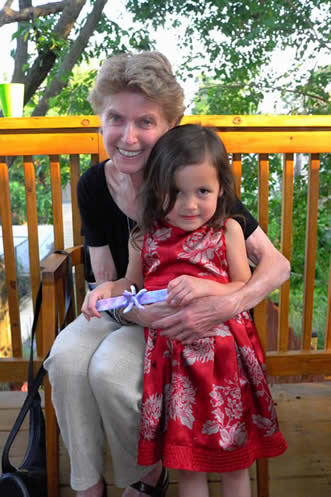
My wife Judy poses with Maia Taylor at a recent party
of our photo colleagues where I passed around the
X1 and X100 for folks to try out. This shot was made
with the Leica. (c) Frank Van Riper
If simplicity defines the X1, the X100’s firmware package presents such a daunting array to the first-time user that, in my opinion anyway, it negates all of its optical and technical virtues. After all, who cares how great a picture-making machine may be if the damn thing is too confusing to use?
And I am not alone in feeling this way. I noticed, for example that the X100’s menus not only were difficult to fathom, each one seemed to look different as well.
Noted one online reviewer: rather than design (firmware) from scratch for the X100, Fuji seems to have shoehorned information from its lesser consumer products into the new camera—with predictable results.
“I'm really glad you brought the Fuji camera with you to try,” noted my friend, former student and colleague, photographer Praveen Mantena, after a recent party of friends in our informal DC-based photo collective. “I had one on order, on a wait list for one, and have been holding out for it since the day it was announced. Needless to say, I'm canceling my order.”
“I absolutely hate the interface which may be the worst I've ever used on a niche camera. Makes you shake your head and wonder really... it's one thing to be quirky, another to be just plain awful. If Fuji copied the Leica M3 so blatantly in their design and bettered it in the weight, quietness and low light shooting ability (all better than Leica managed with their digital M cameras) why didn't they just copy or mimic the best interfaces of the other cameras out there? It ain't rocket science, just sensible execution that has been figured out eons ago.”
“Instead,” Praveen noted, “they gave that job to clueless engineers who obviously know nothing about how real photographers shoot and created a complete design mess.”
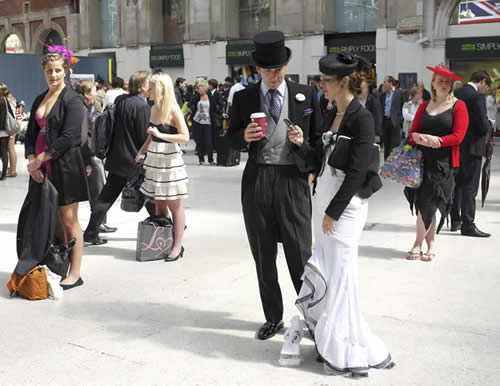 |
Finally, after doping out the X100's complicated firmware, Harry Hamburg was able to make these winners from London. Above: punters at Waterloo Station on their way to Ascot. ©Harry Hamburg |
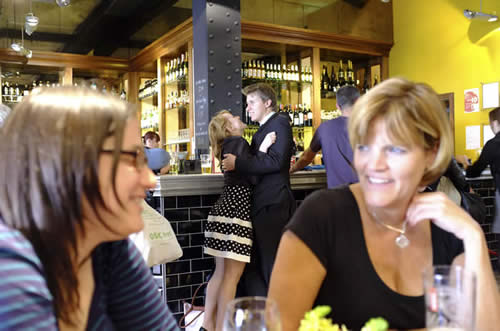 |
Harry hasn't lost his talent for the Decisive Moment, as shown in this quick shot, made with the Fuji X100 at a pub. ©Harry Hamburg |
In fairness to Fuji, I should add the comments of my colleague and friend Harry Hamburg, the (now) London-based photojournalist with whom I spent 20 years on the New York Daily News. When Harry first got his hands on the X100, he exulted, “it’s a Leica!” then retreated to ticked-off grumbling when, in effect, he couldn’t make the camera go.
“I agree on the complexity,” Harry finally said in a recent e-mail from London, “HOWEVER.....I feel like the happy cocker spaniel being trained.,.... and FINALLY, FINALLY... just gets it.
“I feel confident enough to use it for work..... a few more times and I will have it down. Just changing all of the settings for my purposes is now coming easily.
“And just the weight, I throw it in the rucksack and have it with me.... as opposed to just the phone camera.”
Finally, though I may be in the minority here (certainly compared to some reviewers who have been almost orgasmic in their delight with this feature,) I have to say I find the X100’s storied “hybrid finder” a mixed blessing at best.
“Shooting with the optical finder, the X100 instantly swaps to the EVF [electronic viewfinder] and plays what you just shot through the same finder!” gushed one reviewer. And, in fact, it is amazing to make a picture, then see the still digital image that you just shot appearing as if by magic in your viewfinder, while you still have the camera up to your eye.
No doubt: this is a great way to immediately see if you got the shot you wanted, and/or to check your exposure settings against the actual digital image.
Or at least I thought so, until I started to shoot in the real world.
Think about it: you are shooting an event—be it your grandson’s moving up ceremony at school or a presidential appearance—and you need to shoot rapidly and on the fly. Events are quickly changing before you, yet each time you make a shot your world literally freezes before your eye as your camera serves up the still image you just made. In order to shoot again, you have to tap the shutter release, by which time you likely have missed a shot.
Great technological advance or monumental pain in the butt?
Your call.
Van Riper Named to Communications Hall of Fame
Photography columnist Frank Van Riper, author of the award-winning book Down East Maine/ A World Apart, and others was inducted into the City College of New York Communications Alumni Hall of Fame during an awards dinner at the National Arts Club in Manhattan May 6, 2011.
Van Riper, 64, was cited for is long career in journalism and photography and joins a panoply of other famed CCNY writers and artists named to the Hall of Fame in previous years, including playwright Paddy Chayefsky, muckraking author Upton Sinclair, novelist Oscar Hijuelos and columnist and author Irving Kristol.
Van Riper’s formal journalism career began on the New York Daily News, which he joined in 1967, one week after his college graduation. He stayed with The News for 20 years, serving as White House correspondent, national political correspondent and Washington Bureau news editor. He was a 1979 Nieman Fellow at Harvard, and holds the 1980 Merriman Smith Award (with the late Lars-Erik Nelson) from the White House Correspondents Association for deadline coverage of the negotiations to free American hostages held in Iran during the Carter administration.
In 1987 he left daily journalism for commercial and documentary photography, partnering with his wife, photographer and sculptor Judith Goodman.
In 1992, Van Riper became photography columnist of the Washington Post, where his column, “Talking Photography,” appeared in the Camera Works section of Washingtonpost.com (www.TalkingPhotography.com) His book, Talking Photography, a ten-year collection of his columns and other photography writing, was published in 2001.
Van Riper and his wife are co-authors of Serenissima: Venice in Winter, an internationally acclaimed book of photographs and essays, published in 2008.
In October, 2010, they also inaugurated The Umbria Photo Workshops, their first international photography workshop in Umbria, Italy. www.experienceumbria.com
Every summer they also lead the Lubec Photo Workshops at SummerKeys, a series of low-key week-long workshops based in Lubec, Maine. www.SummerKeys.com
Umbria Photo Workshops, Fall, 2011
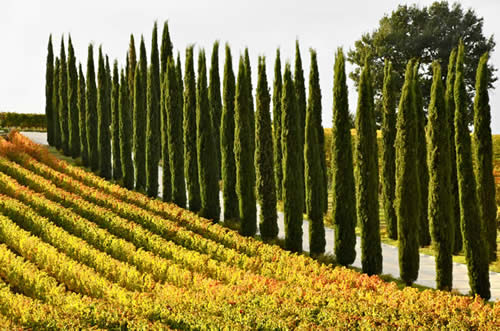 |
| Sagrantino/Cyprus 2 Frank Van Riper |
Join internationally acclaimed husband and wife photographers Frank Van Riper and Judith Goodman for a weeklong photographic workshop under glorious fall skies in one of Italy’s most beautiful regions. This trip is limited to only six participants.
Frank and Judy, authors of the award-winning book Serenissima: Venice in Winter, will share their image-making techniques with a small group during a week covering everything from landscape photography in the verdant hills of Umbria to location portraiture in its closely held olive fields and vineyards.
Participants will travel by guided excursion to several of Umbria’s storied hill towns, including Perugia and Assisi, and receive individual attention during daily critiques.
Package includes 7 nights in the fully restored 17th century villa Fattoria Del Gelso in Cannara, located on a 40-hectare working farm literally walking distance from colorful shops and restaurants and centrally located in the shadow of Assisi. Attentive staff are on hand daily.
This is a trip designed for relaxed learning and sightseeing via foot, bicycle and van, taught by two experienced location photographers whose work has been exhibited in and acquired by major museums in the United States. Frank and Judy are molto simpatico teachers who will turn your photographic vacation into a once-in-a-lifetime adventure.
October 15-22, 2011
Price per person: €1800 (convert to dollars)
Single supplement 400 Euro
Limited to 6 participants
Package includes:
--7 nights in the private villa Fattoria del Gelso
--welcome and farewell dinner
--all breakfasts
--vineyard tour and private lunch
--pizza-making party at the villa
--daily wine and antipasto happy hour
--individual critique and instruction
--private guided walking tours
--ground transportation throughout your stay
—FURTHER INFORMATION: www.experienceumbria.com
Faces of the Eastern Shore
Order Frank Van Riper’s classic look at life on the Chesapeake, Faces of the Eastern Shore, for only $15 (reg. $19.95), plus s/h.
Published in 1992 and printed in duotone, this 10”x 9” quality paperback was featured in the Baltimore Sun, Washington Post and numerous other publications for its superb location portraiture and lyrical text.
Said author James A. Michener in his foreword: “What this rascal has done is belatedly to illustrate my novel, Chesapeake, and superbly.”
Contact Frank directly for copies of this now out-of-print classic: GVR@GVRphoto.com
[Copyright Frank Van Riper. All Rights Reserved. Published 7/11
|